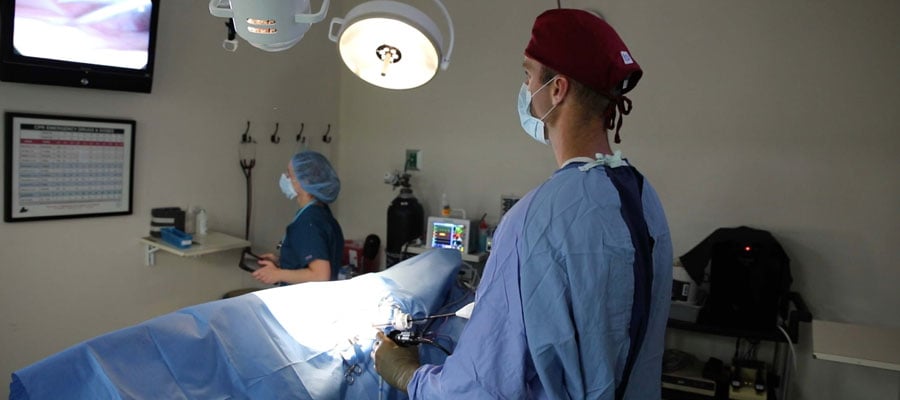So, you and your veterinarian have decided that now is the time to have your dog spayed. Great choice! Which procedure will you choose? Yes, there’s more than one choice. In this blog, we’ll discuss two different spay procedures and the pros and cons of both.
Spaying a dog is a surgery that hasn’t changed much since the 1930s. In this traditional spay, the dog is put under general anesthesia and the veterinarian makes a 2–4-inch midline incision in the dog’s abdomen. The doctor then removes the uterus, ovaries, or both.
Traditionally, the midline incision is the element that takes the longest to heal with this type of procedure. If you’ve ever had a significant incision and sutures, you’ll know they can be very itchy during the healing process. This is where most dogs get themselves into trouble because they like to lick things that itch. Licking and biting those sutures can cause them to come out prematurely which leads to another vet visit to re-suture or staple at best, and an infection at worst. Because of this, most pet owners opt to go home from the day of surgery with their dog in an e-collar (also known as the cone of shame) to help prevent the dog from licking and biting her sutures.
On the upside, the traditional spay is typically the most affordable option and it’s offered and performed at most veterinary clinics and hospitals around the country.
Laparoscopic Spay Arrival
The second, newer option for spaying your dog is a laparoscopic spay. Laparoscopic surgery in the human population started gaining popularity in the late 1980's, and is now widely used. Veterinary medicine is starting to catch on to this less-invasive surgical trend, but it is still not widely offered.
In a laparoscopic spay, your dog will be put under general anesthesia and the veterinarian will make two very small incisions (about 1 inch each) in the abdomen. One incision will be for the specialized laparoscopic surgical tools the doctor will use, and the other incision is for the camera. The camera sends an image to a screen, usually just above the operating table, where the doctor can see what they’re doing inside the patient. The doctor then removes the uterus, ovaries, or both.
As you can probably imagine, these two smaller incisions will heal much faster than the traditional larger incision. The recovery time for a laparoscopic spay is significantly shorter than that of a traditional midline spay. Some dog owners have reported not even needing to use the e-collar!
The downside of the laparoscopic spay is that it does have some additional expenses as opposed to a traditional spay. And, as we mentioned before, it is not offered at every veterinary clinic and hospital.
The upsides are the aforementioned faster recovery time and less possibilities of your dog ripping her sutures out...which of course leads to a lower incidence of infection. For those dogs with boundless energy, it can be stressful for owners and dogs alike to try to keep the dog calm and quiet during the multi-day recovery period from a traditional spay—the quick recovery from a laparoscopic spay will be a game-changer!
The traditional spay has been a great option for successfully spaying dogs for 90 years, and it’s still a great option. Laparoscopic surgery has become the gold standard of care for both humans and animals in the last few decades.
It’s important for you to discuss with your veterinarian which option is best for your dog, your family, and your budget.
